Nucleocapsid - Study guides, Class notes & Summaries
Looking for the best study guides, study notes and summaries about Nucleocapsid? On this page you'll find 96 study documents about Nucleocapsid.
Page 4 out of 96 results
Sort by
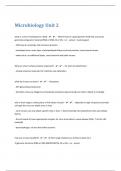
-
Microbiology Unit 2|111 Questions with 100% Correct Answers | Verified | Latest Update |
- Exam (elaborations) • 22 pages • 2023
-
- $7.99
- + learn more
what is a virus? enveloped vs naked - ️️- HAS TO have a capsid (protein shell that surrounds genome) and genetic material (RNA or DNA, SS or DS, + or - sense) = nucleocapsid - CAN have an envelope and accessory proteins - enveloped virus: outer layer of phospholipid bilayer and viral proteins, most animal viruses - naked virus: no additional layers, most bacterial and plant viruses Why are virion surface proteins important? - ️️- for host cell attachment - include enzymes import...

-
WGU C453 Clinical Microbiology Exam Questions with 100% Correct Answers
- Exam (elaborations) • 12 pages • 2024
-
- $12.49
- + learn more
WGU C453 Clinical Microbiology Exam Questions with 100% Correct Answers Bacteria -Answer-Single-celled organism that do not have a cell nucleus and the membrane-enclosed intracellular structures found in most other cells (Prokaryotic cell). Gram-positive Bacteria -Answer-Thick layer of peptidoglycan (20-80nm across). The peptidoglycan layer is closely attached to the outer surface of the cell membrane. Retains crystal violet stains. Lack an outer membrane and a periplasmic space. Gram-neg...
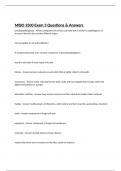
-
MIBO 3500 Exam 3 Questions & Answers
- Exam (elaborations) • 7 pages • 2023
- Available in package deal
-
- $10.49
- + learn more
pseudopeptidoglycan - Answer component of archaea cell walls that is similar to peptidoglycan in structure/function but contains different sugars not susceptible to cell wall antibiotics N-acetylosaminuronic acid - Answer component of pseudopeptidoglycan found in cell walls of some types of Archae histone - Answer protein molecule around which DNA is tightly coiled in chromatin choanocyte - Answer Collar cells that line the body cavity and have flagella that circulate water and di...
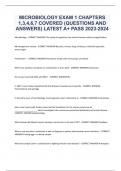
-
MICROBIOLOGY EXAM 1 CHAPTERS 1,3,4,6,7 COVERED (QUESTIONS AND ANSWERS) LATEST A+ PASS 2023-2024
- Exam (elaborations) • 17 pages • 2023
- Available in package deal
-
- $12.99
- + learn more
Microbiology - CORRECT ANSWER-The study of organisims too small to beseen without magnification Microorganisms include - CORRECT ANSWER-Bacteria, viruses, fungi, Protozoa, helminths (parasitic worm) algae Prokaryotes - - CORRECT ANSWER-Prenucleus simple cells microscopic unicellular Which one could be unicellular or multicellular or even both - CORRECT ANSWER-Eukaryotes Do viruses have both DNA and RNA ? - CORRECT ANSWER-No In 1857, Louis Pasteur hypothesized that disease in people was ca...

-
Respiratory Syncytial Virus Questions With 100% Correct Answers.
- Exam (elaborations) • 3 pages • 2023
- Available in package deal
-
- $2.99
- + learn more
How was RSV first discovered? - 1. First isolated in a group of chimpanzees 2. First named "chimpanzee coryza agent" 3. Later it was discovered that the chimps contracted the virus from a lab worker 4. Robert Chanock and his colleagues were able to isolate and characterize the virus in 1963 What are the general characteristics of RSV? - 1. Belonging to genus Pneumovirus 2. Medium sized non-segmented negative sense single-stranded RNA enveloped virus 3. 2 subtypes: A and B, with A being t...

-
MICROB 201 EXAM 3 PRACTICE QUESTIONS AND ANSWERS (100% PASS)
- Exam (elaborations) • 11 pages • 2024
-
- $9.99
- + learn more
MICROB 201 EXAM 3 PRACTICE QUESTIONS AND ANSWERS (100% PASS) housekeeping genes - Answer️️ -genes that are expressed/transcribed all the time; are constitutively expressed (transcribed in an ongoing manner) regulatory proteins - Answer️️ -act as "molecular switches" that control gene expression; bind to regulatory DNA sequences located next to coding region of genes - activator proteins activate gene expression - repressor proteins inhibit gene expression operon - Answer️️...

-
WGU C453 CLINICAL MICROBIOLOGY|UPDATED&VERIFIED|100% SOLVED|GUARANTEED SUCCESS
- Exam (elaborations) • 14 pages • 2023
-
- $16.49
- + learn more
Bacteria Single-celled organism that do not have a cell nucleus and the membrane-enclosed intracellular structures found in most other cells (Prokaryotic cell). Gram-positive Bacteria Thick layer of peptidoglycan (20-80nm across). The peptidoglycan layer is closely attached to the outer surface of the cell membrane. Retains crystal violet stains. Lack an outer membrane and a periplasmic space. Gram-negative Bacteria Cell wall is thinner, but more complex. Only 10-20% peptidoglyc...
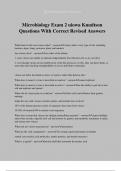
-
Microbiology Exam 2 uiowa Knudtson Questions With Correct Revised Answers
- Exam (elaborations) • 25 pages • 2024
-
- $12.49
- + learn more
Microbiology Exam 2 uiowa Knudtson Questions With Correct Revised Answers What kind of cells can viruses infect? - answerviruses infect every type of cell, including bacteria, algae, fungi, protozoa, plant, and animals Are viruses alive? - answertwo sides of the debate: 1. since viruses are unable to replicate independently from the host cell, so no, not alive 2. even though viruses do not exhibit most of the life processes of cells, they can direct them, so more than inert (lacking stren...
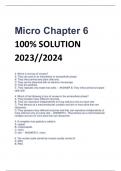
-
Micro Chapter 6 100% SOLUTION 2023//2024
- Exam (elaborations) • 7 pages • 2023
-
- $8.99
- + learn more
Micro Chapter 6 100% SOLUTION 2023//2024 3. Which is not true of viruses? A. They can exist in an intracellular or extracellular phase. B. They infect animal and plant cells only. C. They can be observed with an electron microscope. D. They are acellular. E. They replicate only inside host cells. - ANSWER B. They infect animal and plant cells only. 4. Which of the following is true of viruses in the extracellular phase? A. They possess many different enzymes. B. They can reproduc...
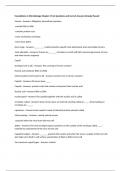
-
Foundations in Microbiology Chapter 6 Test Questions and Correct Answers Already Passed
- Exam (elaborations) • 8 pages • 2024
-
- $7.99
- + learn more
Foundations in Microbiology Chapter 6 Test Questions and Correct Answers Already Passed Viruses - Answers -Obligatory intracellular parasites -contain DNA or RNA -contains protein coat -some enclosed by envelope -some have spikes Host range - Answers ____ ____ is determined by specific host attachment sites and cellular factors. most abundant - Answers Viruses are ___ ___ microbes on earth with NO universal agreement on how and when viruses originate Capsid Envelope (not in all) - Ans...

Do you wonder why so many students wear nice clothes, have money to spare and enjoy tons of free time? Well, they sell on Stuvia! Imagine your study notes being downloaded a dozen times for $15 each. Every. Single. Day. Discover all about earning on Stuvia


